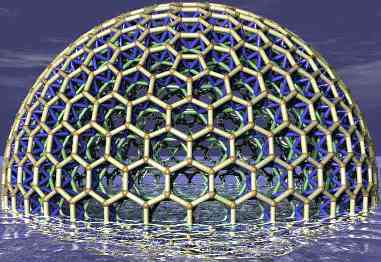
HexDome
Vertical fallacy
Building tall

Manhatten skyline
This downtown New York skyline illustrates an extreme aspect
of 21st century architecture.
Skyscrapers represent a solution to the problem of how to
fit as much floor space as possible over a specified small
area of ground.
However, since they typically lack any kind of lateral
structural support, they make about as much structural sense
as a pencil balanced on its end.
To gain insight into why humans build skyscrapers, it is
helpful to look at some of nature's other tall constructs,
and understand why they form.
Competition

Tall trees
|
Many plants grow tall. Plants can have more than one reason
for wanting to reach for the sky:
- Light access - growing tall reduces the chance of living in another plant's shadow;
- Getting a high point to distribute pollen and seeds from;
- Some plants distribute their seeds by growing tall, and then falling over.
Many trees grow tall in order to get access to
light. Their natural environment constist of an ecosystem
where they are surrounded by other plants competing with
them for light.
In such competitions, the tallest plants get to the light
first - and are selectively favoured.
A designer might look at the resulting canopy and marvel at
the waste represented by the trunks of the trees: if
only the trees could form a cartel - and agree with
each other not to grow quite so tall - much the same degree
of light absorpsion could be obtained, with much reduced
expenditure on tree trunks - resuting in more efficient use
of material and much greater structural stability.
However, therein lies the point of this story. The trees
can't communicate with each other. There is no way they can
form mutually beneficial agreements with one another. It's a
case of every tree for itself.
Under such circumstances, the only stratgey that makes sense
it to behave selfishly - without regard for the overall
consequences of all the other agents behaving similarly.
Following any other strategy is immediately deleterious.
|
Cooperation

Termite mound
|
To contrast with the palm trees, consider this termite mound.
Termites form cooperatives - their nests are colonies in which
the individual termites have many shared interests.
While this mound still exhibits a significant element of
trying to climb skyward, this termite mound shows more
significant signs of cooperative, communal behaviour.
In particular, the spires in the mound share common bases -
and don't attempt to stand vertically without any lateral
support.
These termites aren't quite as obsessed with the right angle
as human beings are either - their towers are turrets -
rather than being rectangular blocks.
|
Conclusions
The thesis of this essay is that skyscrapers share elements
with the palm trees.
They are the the architecture of a failure of cooperation.
Factors that lead to their production include individual
ownership of land, lack of high-level communication and
planning disregard for the immediate surroundings.
I encourage you to think for a moment, what would happen if
the government was in completle control of housing and
shelter, and could design a city from scratch.
Obtaining wayleaves to run lateral supports across your
neighbours property would not be an issue - the same agent
would have rights over all the land in question.
I think the resulting picture would look quite different
from the actual cities we see today - which are
mostly hacked together by Adam Smith's invisible hand -
without any real large scale design or planning.
I reckon future architects will look back at this era and
characterise the skyscraper as the architecture of
individualism - a product of humanity's pre-colonial era.
Tim Tyler |
Contact |
http://hexdome.com/
|